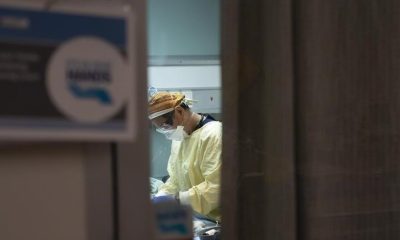Economy
How electric vehicles are ‘fuelling’ the economy of the future
In a nondescript workshop next to a giant service garage in Burnaby, B.C., the next generation of students and instructors is learning the ins and outs of servicing and repairing electric vehicles.
You might associate automotive work with grease, spare parts and noise. But here, the work is quiet – and clean.
Enter the EV economy, built around solving some of the various problems, challenges and opportunities associated with electric cars.
This includes upending the entire idea of what it means to be an automotive service technician in the 21st century. These days, it’s all about integrating the ‘traditional’ – oil, spare parts, fluids – with a ‘knowledge economy’ built around computers, software and circuits.
“Technologists rather than mechanics,” is how Mubasher Faruki, the associate dean of the automotive program at the British Columbia Institute of Technology, characterizes the work they do in these high-tech, data-oriented labs.
Supercharging the auto repair shop
In the specialized EV lab, an instructor, Jim Berladyn, opens up a giant vehicle battery containing 400 volts of electricity, enough to instantly electrocute a person if the pack is not handled carefully.
The whole thing looks more like a physics class than an auto repair shop.
The students are third- and fourth-year apprentices, but also existing technicians looking to upgrade their skills.
Berladyn helps them perform what’s called a “live-dead-live” test to ensure there is no voltage coming out of the battery. They then detach the battery from the underside of the car. They attach monitors to these powerful energy sources to see how they’re working, and to diagnose potential problems in their circuitry.
The students and their instructors get help and support from the vehicle manufacturers, but because the technology is changing so rapidly – “the manufacturers are building the plane as they fly it,” Faruki says – sometimes the class even stumbles across its own little discoveries as they dig into the car’s internal systems.
Some of the newer students, Faruki says, are “a little intimidated” by it, not having expected to be working with computers and data to the extent that they do right from the get-go.
But, he adds, “if the manufacturers are producing these vehicles, then it makes no sense not to teach our students on this.”
EV economic opportunities
Gas-powered cars aren’t going anywhere any time soon, and most EVs are still out of reach for the vast majority of Canadians.
Still, across the country, a range of different economic opportunities are springing up around EVs, as both federal and some provincial governments drastically ramp up their commitments to getting more battery-powered cars on the road.
Figuring out how to service them is, in many ways, the easy part. Technicians, Faruki says, are used to constant change, as technology is constantly evolving in cars – now, with EVs.
But what about improving how you extract the minerals and elements required to make car batteries? Mining done without clear environmental safeguards can have lasting environmental consequences, to say nothing of impacts on people working in the mines.
And what about the perennial problem of charging?
Charging challenges
Canadian entrepreneurs are filling a growing need to solve these challenges.
Charging stations are popping up all over the country, but what happens if you live in a condo, and need a reliable supply of power without unfairly penalizing all the owners of gas-powered cars?
That’s where Zak Lefevre and his startup, ChargeLab, come in.
With a background in software, Lefevre set out to make EV charging seamless.
In condos, for example, car owners don’t want to be subsidizing the power used by a handful of EV owners in the building, much less have their power systems overwhelmed when more EVs start to plug in.
“So what the condo building needs is a software system to know who’s charging, when they’re charging, and bill them fees” for the electricity they are using.
“When the first guy gets a Tesla, that’s OK. When the second girl gets a Tesla, that’s OK. When you have 10 or 20 or 30 people trying to drive electric vehicles, there’s not enough electricity in the building.”
ChargeLab has raised about $21 million USD so far. Lefevre, like many entrepreneurs, isn’t unfamiliar with the experience of knocking on doors trying to raise money only to have them slam shut in your face, especially in Canada.
That, too, was the experience that Amanda Hall faced early on.
Looking for lithium
Her startup, Summit Nanotech, is solving the problem of extracting lithium from the ground in ways that aren’t as harmful to the surrounding environment. That means using less water and producing less waste.
Lithium is a soft, whitish metal that’s an essential component for EV batteries.
There is lithium in Alberta, but it’s mixed in the ground with oil, which makes it costlier to separate and extract. Instead, Summit is eyeing the Atacama Desert in Chile, the site of some of the world’s most highly concentrated and accessible lithium reserves.
The company’s engineers developed the technology at a lab in Calgary. Then, they shipped the equipment needed to do the actual mining and extraction work to Chile in giant sea containers.
Their proprietary technology is still in the research stage, which means they’re not selling the lithium they’re mining out of the ground, at least not yet.
But, says Hall, investors are increasingly seeing the value of diversifying beyond oil and gas, and that includes Canadian investors who weren’t “really up for the risk” of backing a cleantech company.
That’s changed.
The startup has raised nearly $65 million USD, and has gone from 10 staff members in 2020 to 70, says VP of human resources Colleen Ham.
“The price of lithium and the demand for lithium has just continuously chugged uphill,” Hall says.
“Which means that it’s a stable place to sink your money and invest.”
Economic impact
There isn’t a lot of data so far on the direct or indirect economic impacts of electric vehicles.
For example, Statistics Canada has not published any information on how much EVs contribute to Canada’s GDP. What we do know, however, is how many EVs are hitting the road each year, numbers that are fast growing.
The vast majority of new EVs are being sold in Canada’s three largest provinces, Ontario, Quebec and British Columbia. In Ontario, EVs represented 7.2 per cent of all new vehicle registrations in the third quarter of 2022. In Quebec, it was 12.5 per cent, and in B.C., nearly one out of every five new cars sold (17.6 per cent) is an EV.
There’s still a long way to go before EVs become the norm, though. Countrywide, they still represent less than 10 per cent of all new car registrations, and EVs are still out of reach from a price perspective for many customers.
But things are changing rapidly, with governments, electrical utilities and even major oil companies like Petro Canada, Irving Oil and Parkland all investing in charging infrastructure.
That bodes well for entrepreneurs like Zak Lefevre who’ve made big bets on an all-electric future. His company, he says, is “still a small startup.”
But, he adds, “we’re going to wake up one day and find that half of all vehicles being sold are electric.”

Economy
Here is Trump economy: Slower growth, higher prices and a bigger national debt

If Donald Trump is re-elected president of the United States in November, Americans can expect higher inflation, slower economic growth and a larger national debt, according to economists.
Trump’s economic agenda for a second term in office includes raising tariffs on imports, cutting taxes and deporting millions of undocumented migrants.
“Inflation will be the main impact” of a second Trump presidency, Bernard Yaros, lead US economist at Oxford Economics, told Al Jazeera.
“That’s ultimately the biggest risk. If Trump is president, tariffs are going up for sure. The question is how high do they go and how widespread are they,” Yaros said.
Trump has proposed imposing a 10 percent across-the-board tariff on all imported goods and levies of 60 percent or higher on Chinese imports.
During Trump’s first term in office from 2017 to 2021, his administration introduced tariff increases that at their peak affected about 10 percent of imports, mostly goods from China, Moody’s Analytics said in a report released in June.
Those levies nonetheless inflicted “measurable economic damage”, particularly to the agriculture, manufacturing and transportation sectors, according to the report.
“A tariff increase covering nearly all goods imports, as Trump recently proposed, goes far beyond any previous action,” Moody’s Analytics said in its report.
Businesses typically pass higher tariffs on to their customers, raising prices for consumers. They could also affect businesses’ decisions about how and where to invest.
“There are three main tenets of Trump’s campaign, and they all point in the same inflationary direction,” Matt Colyar, assistant director at Moody’s Analytics, told Al Jazeera.
“We didn’t even think of including retaliatory tariffs in our modelling because who knows how widespread and what form the tit-for-tat model could involve,” Colyar added.
‘Recession becomes a serious threat’
When the US opened its borders after the COVID-19 pandemic, the inflow of immigrants helped to ease labour shortages in a range of industries such as construction, manufacturing, leisure and hospitality.
The recovery of the labour market in turn helped to bring down inflation from its mid-2022 peak of 9.1 percent.
Trump has not only proposed the mass deportation of 15 million to 20 million undocumented migrants but also restricting the inflow of visa-holding migrant workers too.
That, along with a wave of retiring Baby Boomers – an estimated 10,000 of whom are exiting the workforce every day – would put pressure on wages as it did during the pandemic, a trend that only recently started to ease.
“We can assume he will throw enough sand into the gears of the immigration process so you have meaningfully less immigration, which is inflationary,” Yaros said.
Since labour costs and inflation are two important measures that the US Federal Reserve weighs when setting its benchmark interest rate, the central bank could announce further rate hikes, or at least wait longer to cut rates.
That would make recession a “serious threat once again”, according to Moody’s.
Adding to those inflationary concerns are Trump’s proposals to extend his 2017 tax cuts and further lower the corporate tax rate from 21 percent to 20 percent.
While Trump’s proposed tariff hikes would offset some lost revenue, they would not make up the shortfall entirely.
According to Moody’s, the US government would generate $1.7 trillion in revenue from Trump’s tariffs while his tax cuts would cost $3.4 trillion.
Yaros said government spending is also likely to rise as Republicans seek bigger defence budgets and Democrats push for greater social expenditures, further stoking inflation.
If President Joe Biden is re-elected, economists expect no philosophical change in his approach to import taxes. They think he will continue to use targeted tariff increases, much like the recently announced 100 percent tariffs on Chinese electric vehicles and solar panels, to help US companies compete with government-supported Chinese firms.
With Trump’s tax cuts set to expire in 2025, a second Biden term would see some of those cuts extended, but not all, Colyar said. Primarily, the tax cuts to higher earners like those making more than $400,000 a year would expire.
Although Biden has said he would hike corporate taxes from 21 percent to 28 percent, given the divided Congress, it is unlikely he would be able to push that through.
The contrasting economic visions of the two presidential candidates have created unwelcome uncertainty for businesses, Colyar said.
“Firms and investors are having a hard time staying on top of [their plans] given the two different ways the US elections could go,” Colyar said.
“In my entire tenure, geopolitical risk has never been such an important consideration as it is today,” he added.

Economy
China Stainless Steel Mogul Fights to Avoid a Second Collapse

Chinese metal tycoon Dai Guofang’s first steel empire was brought down by a government campaign to rein in market exuberance, tax evasion accusations and a spell behind bars. Two decades on, he’s once again fighting for survival.
A one-time scrap-metal collector, he built and rebuilt a fortune as China boomed. Now with the economy cooling, Dai faces a debt crisis that threatens the future of one of the world’s top stainless steel producers, Jiangsu Delong Nickel Industry Co., along with plants held by his wife and son. Its demise would send ripples through the country’s vast manufacturing sector and the embattled global nickel market.

Economy
Why Trump’s re-election could hit Europe’s economy by at least €150 billion
A Trump victory could trigger a 1% GDP hit to the eurozone economy, with Germany, Italy, and Finland most affected. Renewed NATO demands and potential cessation of US aid to Ukraine could further strain Europe.
The potential re-election of Donald Trump as US President poses a significant threat to the eurozone economy, with economists warning of a possible €150 billion hit, equivalent to about 1% of the region’s gross domestic product. This impact stems from anticipated negative trade repercussions and increased defence expenditures.
The recent attack in Butler, Pennsylvania, where former President Trump sustained an ear injury, has boosted his re-election odds. Prediction markets now place Trump’s chances of winning at 71%, a significant rise from earlier figures, while his opponent, Joe Biden, has experienced a sharp decline, with his chances dropping to 18% from a peak of 45% just two months ago.
Rising trade uncertainty and economic impact from tariffs
Economists James Moberly and Sven Jari Stehn from Goldman Sachs have raised alarms over the looming uncertainty in global trade policies, drawing parallels to the volatility experienced in 2018 and 2019. They argue that Trump’s aggressive trade stance could reignite these uncertainties.
“Trump has pledged to impose an across-the-board 10% tariff on all US imports including from Europe,” Goldman Sachs outlined in a recent note.
The economists predict that the surge in trade policy uncertainty, which previously reduced Euro area industrial production by 2% in 2018-19, could now result in a 1% decline in Euro area gross domestic product.
Germany to bear the brunt, followed by Italy
Germany, Europe’s industrial powerhouse, is expected to bear the brunt of this impact.
“We estimate that the negative effects of trade policy uncertainty are larger in Germany than elsewhere in the Euro area, reflecting its greater openness and reliance on industrial activity,” Goldman Sachs explained.
The report highlighted that Germany’s industrial sector is more vulnerable to trade disruptions compared to other major Eurozone economies such as France.
After Germany, Italy and Finland are projected to be the second and third most affected countries respectively, due to the relatively higher weight of manufacturing activity in their economies.
According to a Eurostat study published in February 2024, Germany (€157.7 billion), Italy (€67.3 billion), and Ireland (€51.6 billion) were the three largest European Union exporters to the United States in 2023.
Germany also maintained the largest trade surplus (€85.8 billion), followed by Italy (€42.1 billion).
Defence, security pressures and financial condition shifts
A Trump victory would also be likely to bring renewed defence and security pressures to Europe. Trump has consistently pushed for NATO members to meet their 2% GDP defence spending commitments. Currently, EU members spend about 1.75% of GDP on defence, necessitating an increase of 0.25% to meet the target.
Moreover, Trump has indicated that he might cease US military aid to Ukraine, compelling European nations to step in. The US currently allocates approximately €40bn annually (or 0.25% of EU GDP) for Ukrainian support. Consequently, meeting NATO’s 2% GDP defence spending requirement and offsetting the potential reduction in US military aid could cost the EU an additional 0.5% of GDP per year.
Additional economic shocks from Trump’s potential re-election include heightened US foreign demand due to tax cuts and the risk of tighter financial conditions driven by a stronger dollar.
However, Goldman Sachs believes that the benefits from a looser US fiscal policy would be marginal for the European economy, with by a mere 0.1% boost in economic activity.
“A Trump victory in the November election would likely come with significant financial market shifts,” Goldman Sachs wrote.
Reflecting on the aftermath of the 2016 election, long-term yields surged, equity prices soared, and the dollar appreciated significantly. Despite these movements, the Euro area Financial Conditions Index (FCI) only experienced a slight tightening, as a weaker euro counterbalanced higher interest rates and wider sovereign spreads.
In conclusion, Trump’s potential re-election could have far-reaching economic implications for Europe, exacerbating trade uncertainties and imposing new financial and defence burdens on the continent.

-

 News9 hours ago
News9 hours agoAfter grind of MLS regular season, Toronto FC looks forward to Leagues Cup challenge
-

 News23 hours ago
News23 hours agoCanadaNewsMedia news July 26, 2024: B.C. crews wary of winds boosting wildfires
-

 News10 hours ago
News10 hours agoIn President Milei’s sit-down with Macron, Argentina says the leaders get past soccer chant fallout
-

 News14 hours ago
News14 hours agoOntario expanding access to RSV vaccines for young children, pregnant women
-

 News8 hours ago
News8 hours agoUmicore suspends construction of $2.76B battery materials plant in Ontario
-

 News22 hours ago
News22 hours agoPeople should stay inside, filter indoor air amid wildfire smoke, respirologist says
-

 News18 hours ago
News18 hours agoSuspected train sabotage, bad weather dampen spirits ahead of Paris opening ceremony
-

 News24 hours ago
News24 hours agoFrench train lines hit by ‘malicious acts’ disrupting traffic ahead of Olympics, rail company says

























